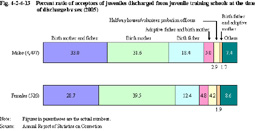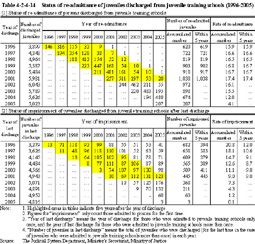| Previous Next Index Image Index Year Selection | |
|
|
3 Juveniles who are discharged (1) Reasons for discharge Table 4-2-4-12 shows the number of discharged juveniles in 2005 by reason.
About 97% were granted provisional discharge with parole supervision and about 3% were granted discharge without parole supervision. For most discharged juveniles, transition from institutional treatment to community-based treatment is smoothly implemented. The average term in juvenile training schools in 2005 was 148 days for general short-term treatment programs, 83 days for special short-term treatment programs, and 386 days for long-term treatment programs (Source: Annual Report of Statistics on Correction). Table 4-2-4-12 Number of discharged juveniles by reason (2005) (2) Places to return Fig. 4-2-4-13 shows persons who accepted discharged juveniles in 2005.
In 2005, the percentage that the acceptor is both of the biological parents declined by nearly 6 points and 4 points for males and females, respectively, from the previous year. Fig. 4-2-4-13 Percent ratio of acceptors of juveniles discharged from juvenile training schools at the time of discharge by sex (2005) (3) Status of re-admittance, etc. Table 4-2-4-14 shows the status of re-admittance of discharged juveniles between 1996 and 2005.
The percentage of those re-admitted to juvenile training schools within five years from discharge was between 16 and 17 percent and the percentage of those admitted to prisons (only those admitted for the first time) within five years from discharge (the last discharge in the case of juveniles who were admitted to juvenile training schools more than once) was between 9 and 12 percent. Table 4-2-4-14 Status of re-admittance of juveniles discharged from juvenile training schools (1996-2005) |


